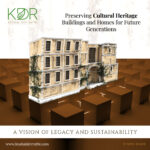Blockchain’s Impact on Cultural Conservation
Preserving our rich cultural heritage requires innovative approaches, and blockchain technology is emerging as a transformative force in heritage conservation funding. This article delves into the profound influence of blockchain, exploring its potential to revolutionize how heritage preservation organizations appeal to donors, with a focus on transparency, community engagement, and the evolving landscape of fundraising.
A Digital Renaissance in Heritage Funding
Traditional heritage conservation often faces funding challenges. Blockchain’s decentralized and transparent nature provides a fresh perspective, attracting both traditional and crypto-savvy donors. The inherent transparency and accountability of blockchain make it an attractive platform for supporting initiatives aimed at safeguarding our shared cultural legacy.
The Potential Game-Changer
By incorporating blockchain technology, heritage conservation organizations can create a transparent and traceable ledger of every donation and transaction. This innovation not only builds trust among donors but also offers them a tangible and measurable impact on preservation efforts. The blockchain becomes a secure repository, ensuring that every contribution is recorded for posterity.
Crypto Membership
Bridging Communities for Heritage
Blockchain’s ability to facilitate crypto memberships introduces a unique fundraising model. Donors are no longer passive contributors but active participants in the preservation process. This sense of community and ownership fosters a deeper connection between donors and the cultural heritage they support. It transforms the act of giving into a shared endeavor with a common goal
Tokenizing Cultural Contributions
Taking a step further, blockchain allows for the tokenization of cultural contributions. Donors can receive digital tokens representing their support, creating a novel form of acknowledgment and engagement. These tokens may grant access to exclusive content, events, or even a stake in decision-making processes, enhancing the overall donor experience and encouraging sustained involvement.
Appealing to New Donors
The transparency, accountability, and community-driven approach offered by blockchain make heritage conservation more appealing to a broader range of donors. Traditional supporters find reassurance in the secure and traceable nature of blockchain transactions. On the other hand, crypto enthusiasts are drawn to the innovative funding model and the opportunity to actively participate in preserving cultural and world heritage.
Blockchain and Corporate Social Responsibility (CSR)
The corporate sector is increasingly recognizing the importance of CSR initiatives. Blockchain’s transparent and accountable framework aligns seamlessly with corporate values. By leveraging blockchain for heritage preservation, organizations can attract corporate partnerships that are not only philanthropic but also align with the company’s commitment to social and cultural responsibility.
Future Implications and Collaborations
As blockchain continues to evolve, its integration with heritage conservation holds even greater potential. Collaborations between blockchain innovators, heritage organizations, and governmental bodies can create a synergistic approach. This collaboration can lead to the development of blockchain-based platforms specifically tailored for heritage preservation, fostering a sustainable ecosystem for funding and conservation efforts.
Building Bridges Through Innovation
In conclusion, the fusion of blockchain technology with heritage conservation not only safeguards our cultural legacy but also reshapes the way we fund and approach preservation efforts. The blockchain emerges as a dynamic force, not only as a guardian of the past but as a bridge that connects communities, traditions, and innovations in the ongoing journey of cultural preservation. The future holds exciting possibilities as blockchain technology continues to weave itself into the fabric of heritage conservation, ensuring our cultural legacy endures for generations to come.




